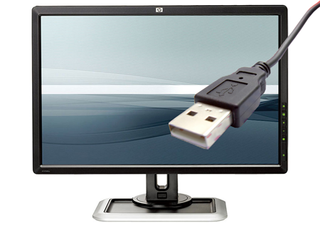USB Monitors? DisplayLink's Technology, Examined

Multi-Monitor Notebooks Enabled By USB?
According to a recent poll we posted to our Facebook page, 61% of you currently own a notebook. If you don't, there's a chance you simply have no need for mobility. Or perhaps you've replaced the heft of a mobile PC with a tablet or smartphone for tasks like answering email or online banking. Nevertheless, we expect the percentage of notebook owners to rise as performance increases and prices continue to drop.

The appeal of notebooks is clear. Plopping down on the couch to browse the Web is far more relaxing than sitting at the same computer desk day after day. But that freedom comes at a price. Even when you move past the fact that mobile systems are necessarily slower at the same price point, you're generally still restricted to a single screen.
Solving that issue isn't easy. Some notebooks include a second display output you can use when there's another monitor available. And we've seen a handful of laptops with AMD-based GPUs that expose Eyefinity functionality, accommodating a third screen. But there aren't many of those around. So, how do you get the flexibility to connect three of four displays at a time? DisplayLink has a solution in its technology that enables graphics over the USB bus, connecting to monitors with USB inputs.
These devices are handy in a pinch, but how do they actually work? We take a deeper look at this technology so you know what to look out for before buying multiple monitors for your mobile workstation.

Test Setup
| System | MacBook Pro 2010 13.3" | Lenovo ThinkPad T410 |
|---|---|---|
| Processor | Intel Core 2 Duo, 2.4 GHz | Intel Core i5-540M (Arrandale), 2.53 GHz |
| Motherboard | - | - |
| Memory | Crucial DDR3-1066 8 GB (2 x 4 GB) | Crucial DDR3-1333 8 GB (2 x 4 GB) |
| Hard Drive | Western Digital Scorpio Blue 1 TB | Seagate Momentus 5400.6 500 GB |
| Graphics | Nvidia GeForce 320M | Nvidia Quadro NVS 3100M |
| Power Supply | - | - |
| Network Card | - | AirPcap Nx USB Adapter |
| System Software and Drivers | ||
| Operating System | Mac OS X 10.6.7 | Windows 7 Ultimate 64-bit SP1 |
| DirectX | - | DirectX 11 |
| Drivers | DisplayLink 1.6 | DisplayLink 5.6 |

All performance testing is performed using a Plugable USB-to-VGA adapter.
Stay on the Cutting Edge
Join the experts who read Tom's Hardware for the inside track on enthusiast PC tech news — and have for over 25 years. We'll send breaking news and in-depth reviews of CPUs, GPUs, AI, maker hardware and more straight to your inbox.
Current page: Multi-Monitor Notebooks Enabled By USB?
Next Page DisplayLink Explored: What's Going On?-
vdr369 looking good, and pretty useful too, it is very useful for notebook users, does this product released in India.Reply -
soccerdocks My notebook has 3 extra outputs. VGA, HDMI, and Display Port. That's plenty for me. I don't see too much of a use for this.Reply -
nevertell When are we going to see DP connectors on most mainstream graphics cards and monitors ?Reply -
SteelCity1981 So when USB 3.0 ports goes to 100w this will eliminate the need for a display link i'd imagine.Reply -
mister g nevertellWhen are we going to see DP connectors on most mainstream graphics cards and monitors ?When Nvidia does so on all their graphics cards, and when manufacterer's finally get the big idea and choose between paying for Displayport or to the DVI Consortium. IGPs also need to switchover or else it won't work.Reply -
WyomingKnott soccerdocksMy notebook has 3 extra outputs. VGA, HDMI, and Display Port. That's plenty for me. I don't see too much of a use for this.For you, no. Other people might find it useful, though. Especially with ultra-portables or other compact devices that tend to have only USB and headphone ports.Reply -
JohnnyLucky I didn't know modern laptops, notebooks, and ultra notebooks might not come with with connections for an external display. I would have thought a connection for an external display would have been standard. Way back in 1993 I purchased a Sony laptop that had an extra video connection. I used it to connect a 21 inch flat screen CRT monitor.Reply -
jamie_1318 I don't think I've ever seen a laptop without at least one external monitor plug. I don't see that being useful to me at least because I don't see needing three screens on a laptop in the immediate future. (I can already dual screen by using the Notebook's display).Reply
SteelCity1981So when USB 3.0 ports goes to 100w this will eliminate the need for a display link i'd imagine.
laptops don't have 100w of power to output to a external GPU, they are probably not going to be on board with this technology. Besides which USB3 is nowhere near fast enough to feed data to a Graphics card in real time, without ever bothering to talk about latency or data-loss. It might be useful if they put very low end Graphics card and powered them off of the USB port, I don't see it becoming common enough to obsolete display port for some time.
-
soccerdocks WyomingKnottFor you, no. Other people might find it useful, though. Especially with ultra-portables or other compact devices that tend to have only USB and headphone ports.My point wasn't that there was no use for this. Merely that there was a small market for this product.Reply -
ram1009 I find myself disagreeing with the whole premise of this topic. Why would anyone want to use a portable while there was a more powerful desktop nearby? It just doesn't compute. IMHO, portables are only to be used for those things you can't do on a desktop.Reply
Most Popular

